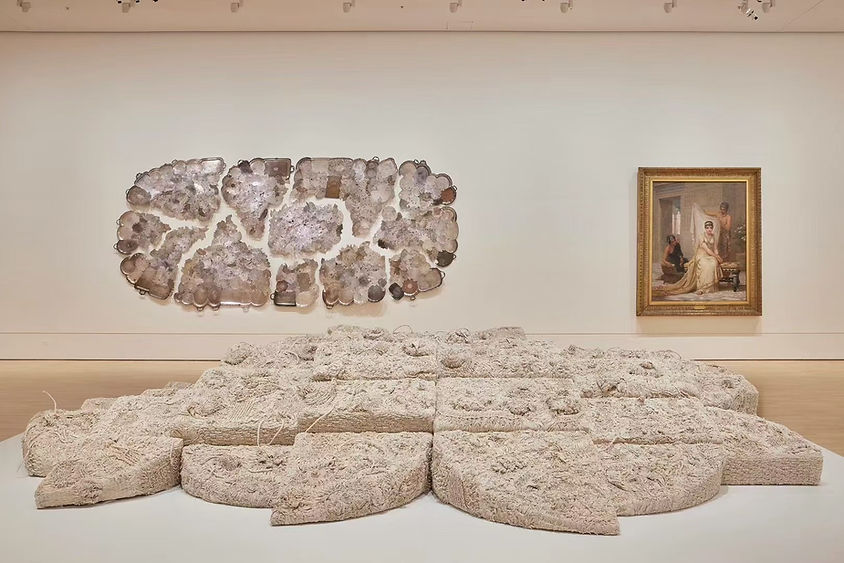She (她)
Lin Fanglu is a young Chinese artist who explores and re-evaluates traditional Chinese female handicrafts using contemporary aesthetic concepts. Incorporating weaving, dyeing, folding, stitching and sculpting into her work, the artist infuses textile art with new vitality and creativity. Lin Fanglu’s works are not simply physical objects, they also bear witness to the treasured traditions and legacy of Chinese craft techniques.
Motherhood and the concept of maternal love have always been crucial sources of creative inspiration for the artist. Growing up in a tailor’s shop, she gained a thorough understanding of fabric, needlework and sewing machines from her mother. This early familiarity with crafting textiles profoundly influenced her later work. The intimate and inherent experience when working with textiles prompted Lin Fanglu to reflect on women’s roles in society and the family unit. Lin believes that women have tirelessly stitched their labour into the fabric of domestic family life, as narrators, educators and caretakers. However, their voices and experiences are often neglected, concealed and silenced in society. Lin Fanglu asserts that despite their devotion to family and home, women cannot easily escape a sense of confinement and isolation amid the rapid pace of societal change.
As a textile artist, Lin Fanglu uses traditional Chinese female craft techniques to create a space for exploring and re-examining the realms of belonging, conflict and alienation. She believes that the art of indigo tie-dye, passed down for thousands of years in Yunnan’s ethnic regions, embodies local women’s unwavering resilience and dedication. The process of extracting and shaping from tradition provides a unique means for Lin Fanglu’s reflections and artistic experimentations, as she adeptly transforms fabrics into contemporary designs and sculptures. As an outsider to the Bai ethnic group, driven by her genuine passion for learning and understanding local crafts, she visited Zhoucheng village in Dali, Yunnan province, China, in 2014. There, she immersed herself in the ancient indigo tie-dye techniques of the community, collaborating closely with local female artisans as she attempted to transcend geographical and ethnic boundaries in pursuit of a harmonious fusion of tradition and creativity.
Bai ethnic indigo tie-dye is an ancient art imbued with unique aesthetic qualities and cultural significance. The deep blue color used in the tie-dye is derived from the indigo plant (Banlangen 板蓝根), which is also used as a traditional Chinese medicine. Bai ethnic tie-dyeing traditionally employs a blue and white color scheme; the Bai people value white for its simplicity, elegance and purity. This time-honored art form has endured over the centuries and continues to represent the artistic expression of the Bai people, and also serves as a material carrier of Bai cultural history.
While learning the indigo tie-dye method from Bai artisans, Lin Fanglu developed a curiosity about the tying process, an essential step in creating intricate patterns on the fabric. She realized its often-overlooked significance and began to think more about the nature of the craft in relation to its creators. Traditionally, transforming a piece of cloth into a tie-dye masterpiece involves using a stencil to mark the outline of a design onto the surface of the cloth. Following the design, the cloth is then bunched and tied with thread in many places, which transforms it into a tightly gathered irregular shape that is then submerged in a dyeing solution and left to dry. Once the fabric is dry, the tied threads are removed to reveal the intricate indigo-and-white design of the finished cloth. The women artisans work diligently to create the exquisite tie-dye patterns, yet their delicate and skillful bunching and tying is ultimately dismantled to achieve the final product. Lin Fanglu sees this act of removing the threads in the process of achieving a result as representative of women’s invisible labour. Consequently, she purposely showcases the stitching and tying of fabrics in her innovations as a respectful tribute to the suppressed narratives and efforts of the Bai women.
Lin Fanglu appreciates the vital role regional female artisans play in preserving traditional crafts, skills and experiences. Due to the aging of artisans from the Bai community, the issue of handicraft inheritance is under threat. In the face of new innovations and market-driven demands, older generations are struggling to keep up with contemporary aesthetic tastes and are holding on to the traditional flower tie-dye motifs of the past. Although Bai ethnic tie-dye is striving to find its place in contemporary society as an important symbol of ethnic identity, the cultural significance of traditional handicrafts has diminished, and the medium through which tie-dye was transmitted has also altered and dissipated. Additionally, indigo plant-based dye is only cultivated in a limited way and has a long growth cycle, making large-scale industrial use difficult. Thus, the technical and environmental concerns surrounding Bai ethnic indigo tie-dye present further daunting challenges when it comes to inheritance of this craft. The need to protect and uphold artistic traditions like Bai ethnic indigo tie-dye has, as Lin would attest, become more pressing than ever.


She
The winner piece of Loewe Craft Prize 2021, Collected by Museum of Decorative Arts in Paris (Musée des Arts Décoratifs)
Cotton Cloth, Cotton Thread, Wood,
600x300x55,
2020

She's Four Seasons
Collected by National Gallery of Victoria, Melbourne, Australia
Cotton Cloth, Cotton Thread, Wood,
600x350x65,
2023


She's Stone
Cotton Cloth, Cotton Thread, Wood
350x620x60 cm
2021
She's Earth
Commissioned by Loewe Foundation
Cotton Cloth, Cotton Thread, Wood
285x415x60 cm
2024

She's Hug
Collected by Samgaksan Geumam Museum of Art, Seoul, Korea
Cotton Cloth, Cotton Thread, Wood
100x100x30 cm
2023


She's River
Cotton Cloth, Cotton Thread, Wood
187x157x20 cm
2024
Elopement Rhapsody
Plant-dyed Cotton, Cotton Thread, Steel
76x76x42/96 cm
2021


She's Blue Landscape
Collected by Michelin Restaurant Jing Cai Xuan, Shanghai
Plant-dyed Cotton, Cotton Thread, Wood
400x100x15 cm
2021

